Protecting the Environment
for Future Generations
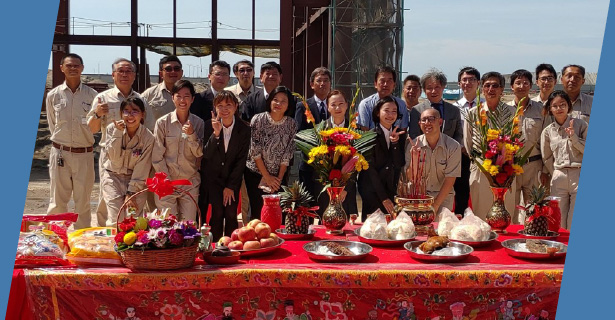
The international community is calling for the "Zero Emissions of Greenhouse Gases by 2050".
In 2013, Kajima formulated "Kajima Environmental Vision Triple Zero 2050" and is working to build an environmentally friendly society
centered on "carbon neutrality", "resource recycling", and "harmoniously co-existing with nature".
Amid differing circumstances in each country, we are continuing to take on a variety of challenges in our overseas operations.
In this Team Story, we will introduce some specific activities and projects.
Chapter 1 Green Building
Green Building is an environmentally friendly building designed with the greatest consideration to improving the overall environmental performance of the building, including the reduction of energy and water consumption for construction and operation, and the greening of facilities. While there are Green Building certification systems around the world, Kajima has achieved these certifications in projects in various countries and is contributing to the establishment of an environmentally friendly society.
Examples of environmental certification systems
in each country
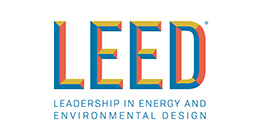
LEED
Birthplace: U.S.A.
Leadership in Energy and Environmental Design(LEED) is an environmental performance evaluation index for buildings and site use sponsored by the U.S. Green Building Council (USGBC). To achieve certification, the evaluation level is determined by the points of the selection after satisfying the prerequisites. LEED is the most widely used green building evaluation system in the world.
Platinum / Gold / Silver / Certified
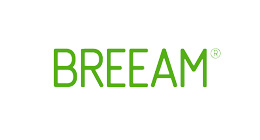
BREEAM
Birthplace: United Kingdom
Building Research Establishment Environmental Assessment Method (BREEAM) is an international index for measuring the sustainability of buildings founded by the Building Research Establishment (BRE) in 1990. It has the oldest history of environmental certification. It is used in more than 80 countries worldwide.
Outstanding / Excellent / Very good / Good / Pass
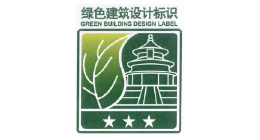
GBAS
Birthplace: China
National standard for green architecture in China announced by the Chinese Housing and Construction Department in 2006.
* Please refer the Certificate of Green Building Design Label that we achieved on the below ‘Challenge amid Covid-19 pandemic (China)’
3 stars / 2 stars / 1 star
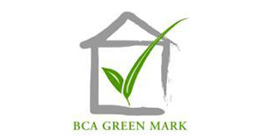
Green Mark
Birthplace: Singapore
A system formulated by Building and Construction Authority (BCA) in 2004. Singapore has established a Green Building Master Plan, which aims to obtain Green Mark certification for 80% of all buildings by 2030.
Platinum / Gold+ / Gold / Certified
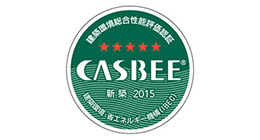
CASBEE
Birthplace: Japan
CASBEE was established in 2001 with the support of the Ministry of Land, Infrastructure, Transport and Tourism as a joint project between industry, government, and academia by establishing the Committee for Comprehensive Environmental Evaluation of Buildings.
S rank / A rank / B+ rank / B-rank / C rank
-
* The LEED wordmark is owned by The U.S. Green Building Council and is used with permission.
-
* “BREEAM is a registered trademark of BRE (the Building Research Establishment Ltd. Community Trade Mark E5778551). The BREEAM marks, logos and symbols are the Copyright of BRE and are reproduced by permission.
-
* The CASBEE Mark Logo is used with the appropriate permission.
Challenge to ZEB (Singapore)
The National University of Singapore (NUS) called a tender for new construction of its School of Design and Environment 4 (SDE4), to have net-zero energy consumption (Net ZEB). Kajima Overseas Asia (KOA) collaborated with KaTRIS (Kajima Technical Research Institute Singapore) to propose our value-addition by Kajima. Our proposal included:
- Involvement of our R&D staff for planning stage for analysis and projection
- Experiment and verification support
- Verification in operation stage
- Implementation of feedback for improvement for the future planning
Our proposal fits to the needs of client and project team, KOA was awarded for this project, delivered the project on schedule in December 2018.
Singapore has a common issue of high energy consumption for cooling by having a low room temperature setting. This building was adopted a hybrid air conditioning system to maintain comfort by combining a ceiling fan that conducts circulation of cooled air to have minimal usage of air conditioning. KaTRIS contributed to analyze and verify the human comfort levels through simulation with mock-up rooms to establish a comfortable environment while being net zero energy. This project also triggered joint research with NUS in the field of "construction and the environment".
Singapore is aiming to get Green Mark certification for 80% of all buildings by 2030. In SDE4, in addition to achieving ZEB, they have acquired Platinum, the highest ranking of the Green Mark.
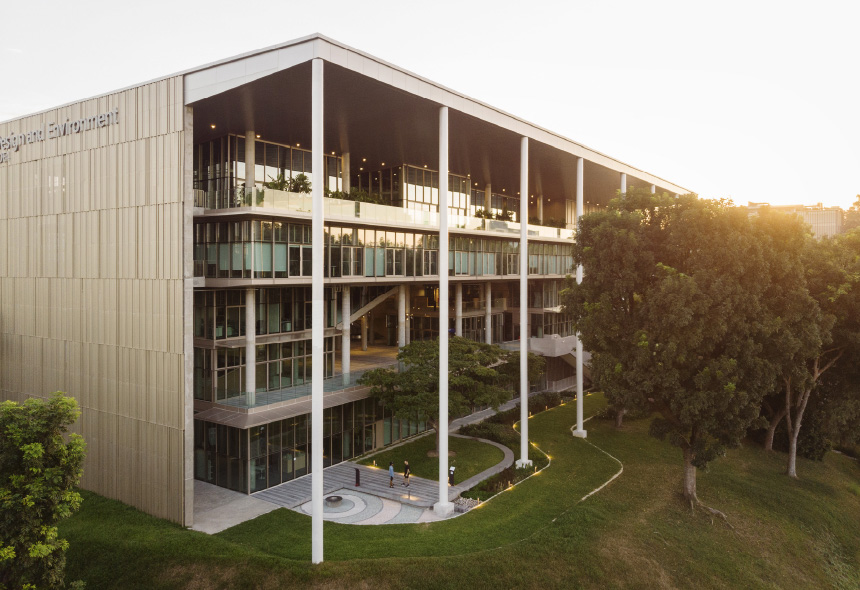
The National University of Singapore
- Project outline
-
- Owner: National University of Singapore
- Design: Surbana Jurong, Serie+Multiply Consultants
- Construction: Kajima Overseas Asia (Singapore) Pte. Ltd.
- Location: Kent Ridge Campus, National University of Singapore
- Outline: Educational Facilities, RC-built, 6 stories
- Total floor area: 12,270 m2
- Construction period: October 2016 to December 2018
Video: SDE4, net zero energy building
Inland Empire Utilities Agency
New Water Quality Lab/Central Chiller Plant Expansion (U.S.A.)
Inland Empire Utilities Agency (IEUA) is a regional wastewater treatment agency, which is responsible for serving western San Bernadino County, California. The Agency is focused on providing three key services: (1) treating wastewater and developing recycled water and local water resources; (2) converting biosolids and waste products into a high-quality compost made from recycled materials; and (3) generating electrical energy from renewable sources.
IEUA's existing main analytical water chemistry laboratory, which had approximately 6,200 square feet of space, was found to be insufficient in regard to space to accommodate the Agency's current laboratory needs. The facility was also in need of seismic retrofitting along with refurbishing and modernizing of the HVAC, plumbing and electrical systems. To accommodate IEUA’s current and future laboratory needs, a new 17,000 square feet laboratory was designed adjacent to the existing facility.
The Austin Company, a subsidiary of Kajima U.S.A., was in charge of master planning, architectural design and engineering design for this project. The new main laboratory was planned to house Organic, Inorganic and Water Quality laboratories, offices, and associated support spaces. The interior of the building was developed around a central corridor system with laboratories and offices located opposite each other. All spaces were designed using a planning module to allow for future flexibility for both the laboratories and offices. In addition, individual room adjacencies were planned to provide clear and logical workflow for the transfer of samples through the building.
New facility provides analytical support to the Agency's five recycling facilities and the Ground Water Recharge Program for process operations as well as compliance monitoring per the National Pollutant Discharge Elimination System. The laboratory also provides analytical support to the Agency’s Pre-Treatment/Source Control Department to monitor industrial wastewater and the cities' domestic wastewater. This project achieved LEED Gold Certification.
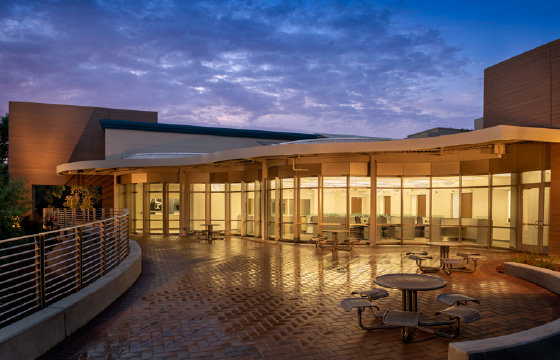
IEUA New Water Quality Laboratory
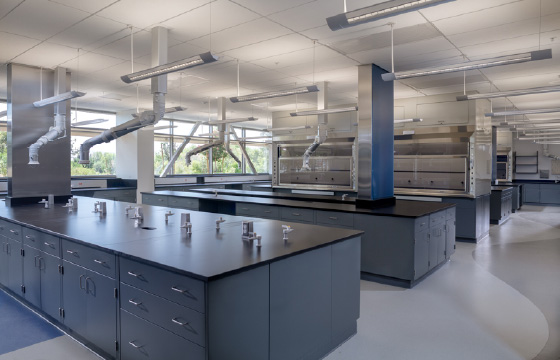
Interior
- Project outline
-
- Owner: Inland Empire Utilities Agency
- Design: The Austin Company (Master planning, architectural design and engineering services)
- Construction: Kemp Bros. Construction, Inc.
- Location: Chino, California, USA
- Use: Laboratory, Chiller Plant
- Year of completion: 2019
(Reference) Kajima Building & Design Group Green Building Initiatives
Achieved BREEAM Excellence (Poland)
Kajima Poland has obtained LEED and BREEAM certification for many projects. In 2021, they achieved a BREEAM Excellent level in Industrial Facilities category for the construction of Panattoni Świebodzin new fulfillment center, which was completed in August 2021. This is the first time that Kajima Poland has obtained an Excellent level in BREEAM.
This new distribution center is built for Panattoni Development Europe - U.S owned major commercial developer and Kajima Europe’s development group and is occupied by the world largest online retailer as a tenant.
Following the construction of a distribution center in Boleslawiec in 2018 and a fulfillment center in Lodz in 2019, this is Kajima Poland’s third project for this tenant. It has a total floor area of 200,000 ㎡ and is one of the largest of its kind in Poland. In addition to its size, as the entire building has four levels that is unique for warehouses, it was a challenge to the scale, short construction time and multi-story structure. However, they successfully completed the project, and the building was delivered to the client on time.
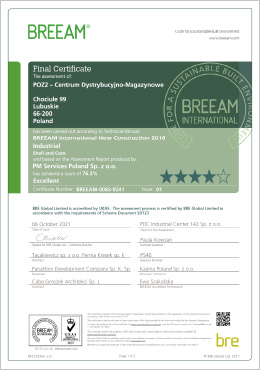
BREEAM Certificate
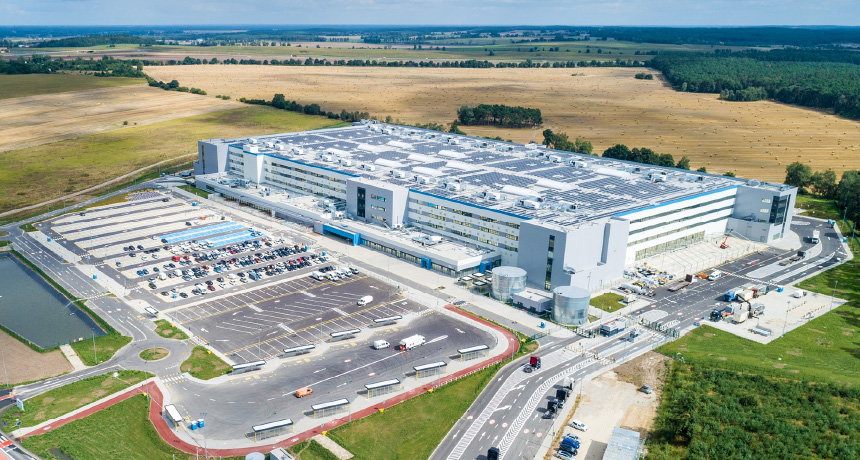
Panattoni Świebodzin new fulfillment center
- Project Outline
-
- Owener: Kajima Panattoni Development JV
- Design: BP; Client (Ferma Kresek), ED; KAJ (CiG)
- Construction: Kajima Poland
- Location: Świebodzin, Poland
- Outline: Logistics facility, 4 stories, 1 basement
- Total floor area: 200,000 m2
- Construction period: June 2020 to August 2021
Challenge amid Covid-19 pandemic (China)
Ricoh's new plant, located in Dongguan City, Guangdong Province, China, was planned to be the Ricoh Group's most advanced environmental plant working to reduce carbon dioxide emissions. Kajima Corporation (China) Co., Ltd., Kajima's Chinese subsidiary, was in charge of design and construction in this project.
They adapted solar power generation facilities, replacement ventilation and air conditioning systems, natural lighting and natural ventilation, etc. Although Covid-19 was rampant during construction and had a major impact on site operations, Kajima (China) used drones and other state-of-the-art IT systems to conduct remote site management. In addition, they also achieved zero accidents. This project achieved the highest Chinese environmental certification [3-stars green Building] and LEED Gold Certification.
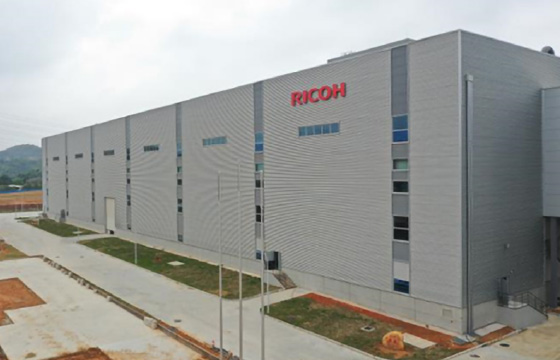
Dongguan Plant
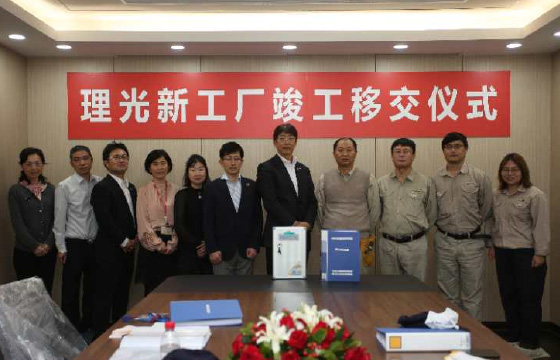
Team members
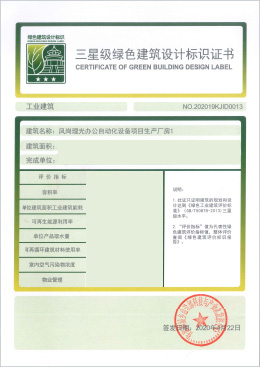
Certificate of Green Building Design Label
- Project Outline
-
- Owener: Ricoh Manufacturing (China) Ltd.
- Design: Kajima Corporation (China) Co., Ltd
- Construction: Kajima Corporation (China) Co., Ltd
- Location: Dongguan, Guangdong Province, China
- Outline: Multi-function machine and printer manufacturing plant
- Total floor area: approximately 96,000 m2
- Construction period: August 2018 to March 2020
Chapter 2 Participation in Projects to Realize a Carbon Neutral Society
In order to reduce greenhouse gas emissions, which are a major cause of global warming, attention is increasingly for renewable energy, natural energy, and recyclable resources. As various companies move forward with initiatives on the global stage, Kajima is also participating in projects in the field of construction and supporting the realization of a carbon neutral society.
Project 1
Siemens Gamesa Taichung Nacelle Assembly Facility (Taiwan)
Siemens Gamesa Renewable Energy is turbine manufacturer in renewable energy for 40 years, which is the global market leader for offshore wind turbines, one of the fastest growing electricity generation sources globally. In Taiwan, the company launched a project of offshore Nacelle Assembly Facility, the first offshore Nacelle Assembly Facility in Asia. Chung-Lu Construction, our Taiwan subsidiary, was in charge of construction.
Nacelle is a very important part of offshore wind power that increases the number of revolutions transmitted from the blade with a speed increaser and converts that revolution into electricity with a generator. This facility will be the base for manufacturing nacelle of about 16 m in length and 9 m in height.
Sand piles were adopted as ground improvement because the site is located in the reclaimed land of Taichung Port. In addition, a double-layered truss structure system is designed on both east and west sides to support the overhead travelling crane inside the facility. The construction work was affected by the salt and sand dust produced by Northeast Monson in the coastal area, but we took thorough measures and eventually delivered the facility to our client with zero accident.
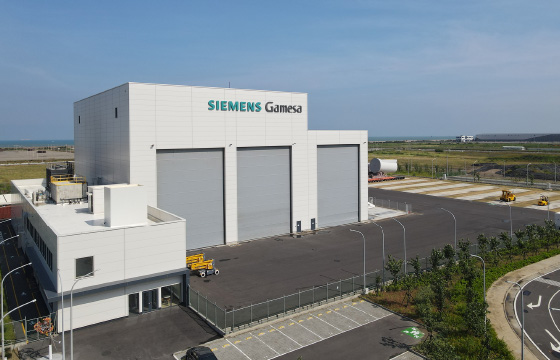
Exterior view of the plant
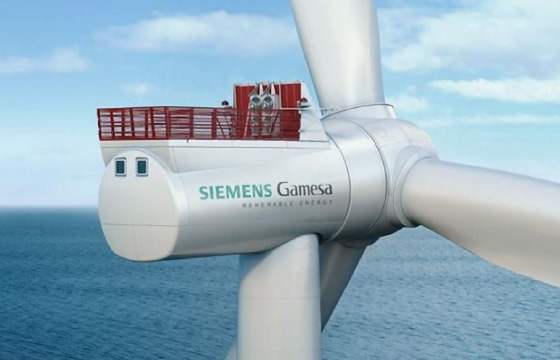
Nacelle segment
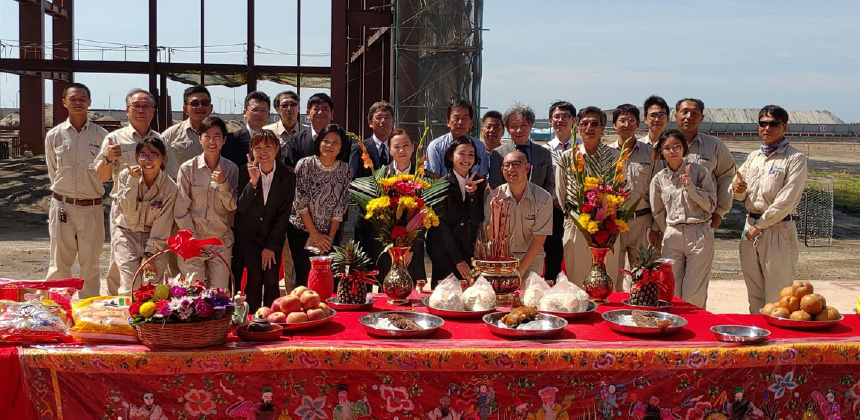
Team members
- Project Outline
-
- Owener: Siemens Gamesa Renewable Energy
- Design: AECOM
- Construction: Chung-Lu Construction
- Location: Longjing district, Taichung City, Taiwan (Taichung Port Industrial Area)
- Overview:
(Factory, Office) Steel, two stories /
(Security room) Reinforced Concrete, one story - Total floor area: 3,790 m2
- Construction period: February 2020 to May 2021
Project 2
The Hydrogen Liquefaction and
Loading Terminal (Australia)
The Victoria, Australian and Japanese Governments support demonstration tests to build Hydrogen Energy Supply Chain. This project is the first in the world to produce hydrocarbons from brown coal and transport them to Japan. AGL Energy Ltd, a major Australian energy company, and six companies were involved in the project. Kawasaki Heavy Industries, Ltd., Electric Power Development Co., Ltd., Iwatani Corporation, Marubeni Corporation, and Sumitomo Corporation. If realized, low-cost hydrogen will be able to be procured stably, and it is attracting attention from around the world toward the realization of carbon neutral society. In this project ICON CO, an Australian subsidiary of Kajima, was in charge of the construction of a hydrogen liquefier and loading base, which will serve as a facility for liquefaction, storage, and shipment.
Although the facility is for demonstration tests, the same level of quality control as a commercial plant was required. It was the first time for ICON to take on a hydrogen-related facility, but they leveraged their quality control capabilities, such as piping connections, cultivated through the construction of pharmaceutical facilities and research facilities. As a result, they were able to successfully complete the project with the cooperation and guidance of the owner.
On February 2022, the hydrogen produced from the Latrobe Valley’s brown coal in Victoria, Australia was chilled to-253°C and liquefied at this facility in Hastings, and then shipped from an adjacent dock to the Kobe Liquefied Hydrogen Cargo Handling Demonstration Terminal in Japan. The project aims to carry out a series of technological demonstrations necessary for the building of Hydrogen Energy Supply Chain and commercialization around 2030.
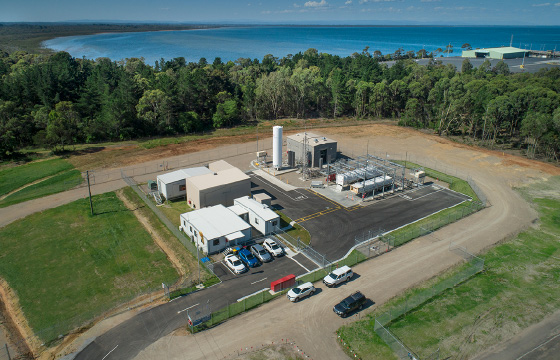
HLLT Overview (Photo by HESC Project Partners)
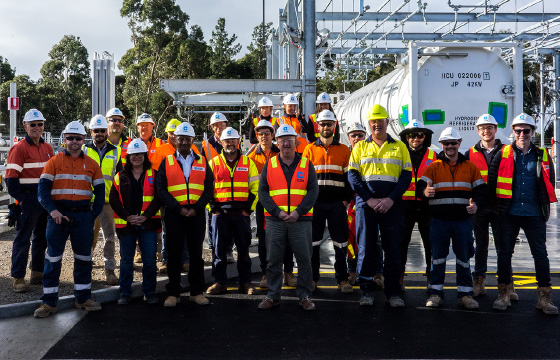
Team members
- Project Outline
-
- Client: Hydrogen Engineering Australia (Subsidiary company of Kawasaki Heavy Industries, Ltd)
- Design: Kawasaki Heavy Industries, Ltd.
- Construction: ICON CO
- Location: Hastings, Victoria, Australia
- Outline: Steel/block wall construction 1 story
- Total floor area: 700 m2
- Construction period: March 2019 to June 2020
Chapter 3 Renewable Energy Development Project (Europe)
In our overseas operations, Kajima will not only acquire environmental certificates and participate in the construction of green buildings we will also take part in renewable energy projects to support a sustainable society.
Kajima Europe (KE) has acquired a majority stake (approximately 70%) in PAD-RES - a leading developer of renewable energy power generation facilities in Poland and moved into the renewables sector.
Poland relies on coal-fired thermal power for about 70% of their power generation, and the Polish government has set a target to raise the renewables share to at least 23% of their energy consumption by 2030. KE (through its subsidiary PAD-RES) secures land lease contracts, obtains building permits for the construction of wind and solar power facilities, obtains the necessary grid connection agreements and power sales contracts and, once construction of the facilities is complete, will sell the project to electricity companies and investment funds.
In addition to the Polish project, Kajima Europe is also engaged in a joint venture with developer, Low Carbon Alliance, that specialises in the early stages of renewables projects, such as site selection, securing land lease contracts, grid connection agreements and the obtaining of planning permits in the United Kingdom where the renewable energy business is advanced. Kajima Europe will sell these projects at “ready to build” stage, prior to construction, to investment funds. We will accumulate knowledge of the renewable energy business by making use of KE’s vast experience in this field.
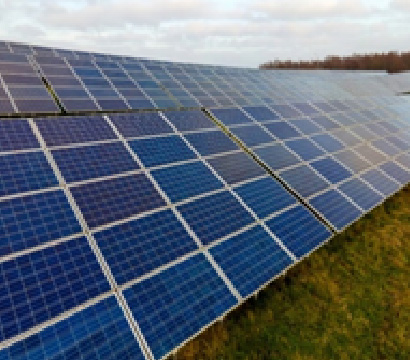
Renewable energy power generation facilities developed by PAD-RES
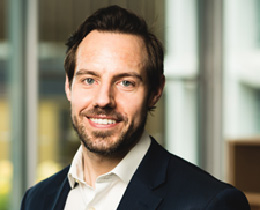
Chris Gill
Projects & Investments Director
Chris played a key role in building a platform for renewable energy businesses in the UK and Poland. He has had an experience of the renewables business at a major infrastructure company in the United Kingdom.
Please see here for details on environmental initiatives in Japan.
- KAJIMA MONTHLY REPORT DIGEST
August 2021: Special issue "Carbon Neutral and Construction Industry (Japanese version only)" - Kajima's environmental technology (Japanese version only)
- Sustainability > SDGs and Kajima's Business Activities
- Sustainability > Environment > Carbon Neutrality
- Technology and Services > Renewable energy (Japanese version only)
